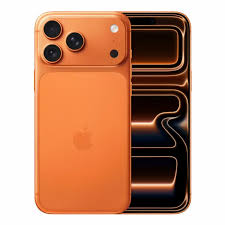Samsung Galaxy S25 Ultra
This is one of the “do everything well” phones. It features a huge crisp display, powerful chipset (Snapdragon 8 Elite or Samsung’s top-tier chip depending on region), and a versatile camera setup (including strong zoom and low-light performance). It’s for people who want premium features: design, camera, performance, screen all top-notch. The tradeoff is cost, size, and sometimes weight — carrying a feature-packed giant.
iPhone 17 Pro Max
If you prefer iOS, this is Apple’s top for 2025. Excellent system optimization, long software support, great video and photo capabilities, and typically class-leading build quality. If you rely on things like ProRes video, content creation, or want seamless integration with the Apple ecosystem, this is a strong pick. Downsides: less flexibility than Android, higher cost, and you may sacrifice some hardware “fun” features in the trade for consistency.
Xiaomi 15 Ultra
This one stands out for camera power and charging. It packs a 1-inch main sensor, multiple lenses (wide, ultrawide, periscope) that perform very well, especially in zoom and low-light. Rapid charging is also a highlight (both wired and wireless). If you want a premium Android device that pushes the limits especially in photography, this is for you. But such specs tend to increase price, and devices this powerful are often heavier or thicker, and the battery life under heavy use may drop.
Vivo X200 Ultra
Excellent for camera lovers and those who want high specs. It has one of the most impressive camera configurations in 2025, showing up in many reviews as among the best for zoom, detail, and photographic flexibility. Also strong display, large battery, fast charging. The catch: global availability is often limited. Warranty, service, or local support might be weaker in some markets. Also, with so much power comes larger size and sometimes heating under heavy load.
OnePlus 15
OnePlus usually balances performance, design, and price well, and this model is no exception. It introduces the new Snapdragon 8 Elite Gen-5, strong display tech (high refresh rate, adaptive), and improvements in durability (frame, finishes). Good choice if you want high performance and premium feel but maybe don’t want to spend at the very top. Just check if the model you get has all the features in your region (camera version, charger, network bands, etc.).
Honor Magic 7 Pro
Honor’s Magic series is known for pushing camera features (especially zoom), AI tools, and often good value for a flagship. Magic 7 Pro brings periscope zoom, strong optics, and build quality. If zoom photography or making distant subjects look good matters to you, this phone delivers. Tradeoffs again include price (flagships tend to be expensive), and sometimes software/usability details and after-sale support may vary depending on region.
Sony Xperia 1 VII
This is more niche: great display, audio, and a phone for photographers or videographers who care about color accuracy, cinematic framing, etc. Sony tends to deliver excellent display quality, audio features, and usability for creators. But it may lack in fast charging compared to competitors, may be bulkier, and price per “feature” can be high. If you want a premium device for creative work (video/photo), this is strong.
Oppo Find X8 Pro
Oppo continues to compete in the premium space, and the Find X8 Pro delivers high-end camera capabilities, sleek hardware, and fast charging. It’s especially attractive to users who want great camera quality plus stylish design and a good UI experience. Oppo phones sometimes have smaller “trade-downs” like less global availability or certain features that differ in “global vs local version,” so check before purchase.
Google Pixel 9 Pro
Google’s Pixel line often wins on software + camera synergy. Pixel 9 Pro for 2025 delivers strong computational photography, excellent low-light shots, and features driven by AI/software rather than just raw hardware. If you value software experience, clean updates, and good photo output without having to fiddle too much, Pixel is solid. On the flip side, hardware (battery life, raw specs) may not always match others, especially in categories like zoom or ultra-fast charging.
Foldables & Unique Form Factor Picks – Samsung Galaxy Z Fold 7
If you want something different, foldables are now mature enough to be practical. The Z Fold 7 offers a large internal screen for multitasking, good performance, solid build, and has become more refined. If your phone usage includes reading, multitasking, content creation or use as a small tablet, this can be game-changing. But tradeoffs: durability can still be a concern, cost is high, and carrying a foldable is different (weight, hinge, etc.).
What to Consider (So You Pick Right)
Availability & Local Version: Many powerful phones are “flagship in their home market” but some features or support may not work fully where you live.
Camera vs Other Needs: If your priority is zoom, low-light photography, or video, pick one of the camera-centric phones. If battery life, display smoothness, or software updates are more important, maybe pick a more balanced device.
Size, Weight, Durability: Flagships are often big. If you prefer smaller phones or lighter weight/thinner design, you may compromise on some specs.
Software & Updates: Check how many years of OS + security updates the manufacturer provides. Pixel and Apple tend to lead here.
Charging Speed & Battery: Fast charging is great, but it’s also about how well battery holds up over time. Sometimes phones with slower charging but better battery health are more satisfying.
Price vs Long-Term Value: Spending more up front might give you a phone that lasts 3-4 years without needing an upgrade. Consider resale, replacement cost, repairs.



